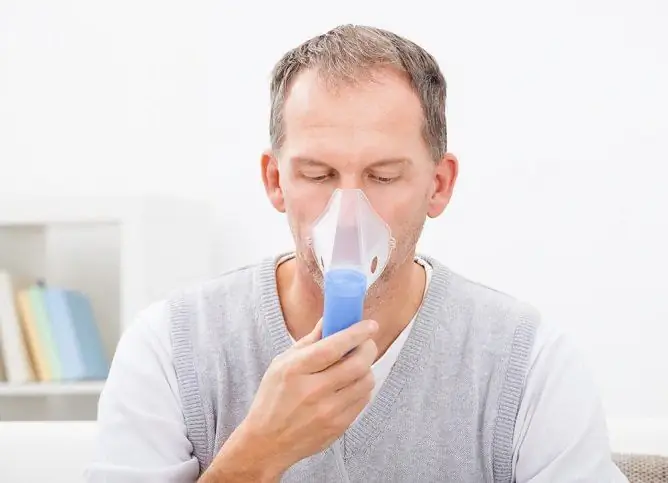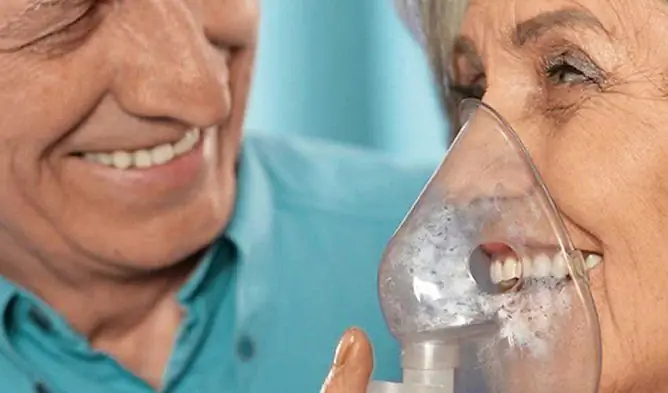- Author Rachel Wainwright [email protected].
- Public 2023-12-15 07:39.
- Last modified 2025-11-02 20:14.
Ambroxol-SOLOfarm
Ambroxol-SOLOfarm: instructions for use and reviews
- 1. Release form and composition
- 2. Pharmacological properties
- 3. Indications for use
- 4. Contraindications
- 5. Method of application and dosage
- 6. Side effects
- 7. Overdose
- 8. Special instructions
- 9. Application during pregnancy and lactation
- 10. In case of impaired renal function
- 11. For violations of liver function
- 12. Drug interactions
- 13. Analogs
- 14. Terms and conditions of storage
- 15. Terms of dispensing from pharmacies
- 16. Reviews of Ambroxole-SOLOpharm
- 17. Price in pharmacies
Latin name: Ambroxol-SOLOpharm
ATX code: R05CB06
Active ingredient: ambroxol (Ambroxol)
Manufacturer: Grotex, LLC (Russia)
Description and photo update: 2019-10-07

Ambroxol-SOLOpharm is a drug with expectorant, mucolytic action.
Release form and composition
Dosage form - solution for oral administration and inhalation [in foil bags 10 tubes A, containing 1 or 2 ml of solution, and 10 tubes B, containing 1 or 2 ml of solvent, in a cardboard box 1 or 2 bags with tube-droppers A and B (set) or only with tube-droppers A and instructions for use of Ambroxol-SOLOpharm].
Composition of 1 ml of solution (tube-dropper A):
- active substance: ambroxol hydrochloride - 7.5 mg;
- auxiliary components: sodium chloride - 6.22 mg; sodium hydrogen phosphate dihydrate - 4.35 mg; anhydrous citric acid - 1.83 mg; water for injection - up to 1 ml.
Composition of 1 ml of solvent (tube-dropper B): sodium chloride - 9 mg, water for injection - up to 1 ml.
Pharmacological properties
Pharmacodynamics
According to the studies carried out, the action of Ambroxol - the active component of Ambroxol-SOLOpharm - is aimed at increasing secretion in the respiratory tract. It enhances the production of pulmonary surfactant and has a stimulating effect on ciliary activity. This increases the flow and transport of mucus (mucociliary clearance), which in turn leads to an improvement in sputum discharge and relief of coughing.
Long-term therapy with ambroxol (lasting at least 2 months) against the background of chronic obstructive pulmonary disease provides a significant decrease in the number of exacerbations. There is a significant decrease in the number of days of antibiotic therapy and the duration of exacerbations.
Pharmacokinetics
All dosage forms of immediate release ambroxol are characterized by rapid and almost complete absorption from the gastrointestinal tract, with a linear dose dependence in the therapeutic concentration range. When taken orally, C max (maximum concentration of the substance) in the blood plasma is achieved in 1-2.5 hours. V d (volume of distribution) - 552 liters. The binding of the substance to plasma proteins in the therapeutic concentration range is approximately 90%.
With oral administration, there is a rapid transition of Ambroxol from blood to tissue, with the highest concentrations of the substance observed in the lungs. About 30% of the dose is affected by the primary liver pass.
According to studies on human liver microsomes, the predominant isoform responsible for the metabolism of the active substance to dibromantranilic acid is the CYPZA4 isoenzyme. The rest of the dose is metabolized in the liver, mainly by glucuronidation and partial degradation to dibromantranilic acid (approximately 10% of the dose), as well as a small number of additional metabolites.
Terminal T 1/2 (half-life) of the substance - 10 hours. Total clearance is within 660 ml / min, renal clearance is approximately 8% of total clearance. It has been calculated (using the radioactive labeling method) that after taking a single dose, approximately 83% of the dose is excreted in the urine over the next 5 days.
Indications for use
Ambroxol-SOLOfarm is prescribed for the treatment of the following respiratory diseases with the release of viscous sputum (acute and chronic course):
- acute and chronic bronchitis;
- chronic obstructive pulmonary disease;
- pneumonia;
- bronchiectasis;
- bronchial asthma with difficulty in sputum discharge.
Contraindications
Absolute:
- I trimester of pregnancy;
- period of breastfeeding;
- individual intolerance to the components of the drug.
Relative (solution for oral administration and for inhalation Ambroxol-SOLOfarm is prescribed under medical supervision):
- impaired renal function;
- severe liver disease;
- impaired motor function of the bronchi and increased production of sputum (in patients with immobile cilia syndrome);
- exacerbation of gastric ulcer and duodenal ulcer;
- II - III trimesters of pregnancy.
Ambroxol-SOLOfarm, instructions for use: method and dosage
Ambroxol-SOLOfarm is taken orally. The mucolytic effect develops when a large amount of liquid is consumed, and therefore, abundant drinking is recommended during the period of therapy.
Oral administration
For oral administration, a solution of ambroxol is used from a tube-dropper A. Ambroxol-SOLOpharm is added to water, fruit juice, tea or milk. The drug is taken after meals.
Children over 12 years old and adults in the first 2-3 days of therapy are prescribed 3 times a day, 4 ml, after which the frequency of administration is reduced to 2 times a day. The maximum daily dose is 90 mg per day.
Recommended dosing regimen / maximum daily dose for children:
- 6-12 years: 2-3 times a day, 2 ml / 45 mg;
- 2-6 years: 3 times a day, 1 ml / 22.5 mg;
- up to 2 years (under medical supervision): 2 times a day, 1 ml / 15 mg.
Inhalation use
Any modern inhalation equipment (except for steam inhalers) can be used for inhalation of Ambroxol-SOLOpharm.
Before use, the solution from the dropper tube A is mixed with the solvent from the dropper tube B (mixing in a 1: 1 ratio allows for optimal air humidification). Before inhalation, it is recommended to warm the solution to body temperature.
Inhalation is carried out 1-2 times a day in the following single doses:
- adults and children from 6 years old: 2-3 ml;
- children under 6 years old: 2 ml.
The recommended duration of therapy is 4-5 days. Longer-term use of Ambroxol-SOLOpharm should be agreed with your doctor.
Taking a deep breath during inhalation therapy can provoke a cough, so inhalations should be carried out in a normal breathing mode.
In order to avoid nonspecific irritation of the respiratory tract and their spasm, inhalation is recommended for patients with bronchial asthma after taking bronchodilators.
Side effects
During therapy with Ambroxol-SOLOpharm, the following adverse reactions may develop (> 10% - very often;> 1% and 0.1% and 0.01% and <0.1% - rarely; <0.01% - very rarely):
- respiratory system: rarely - rhinorrhea, dryness of the mucous membrane of the respiratory tract;
- skin and subcutaneous tissues: very rarely - Lyell's syndrome, Stevens-Johnson syndrome;
- digestive system: often - nausea, decreased sensitivity in the pharynx and mouth; infrequently - pain in the upper abdomen, dyspepsia, diarrhea, vomiting; rarely - constipation, heartburn, dryness of the mucous membrane of the pharynx and oral cavity;
- immune system: rarely - urticaria, hypersensitivity reactions, skin rash, angioedema, itching; very rarely - anaphylactic reactions, including anaphylactic shock;
- nervous system: often - disturbances in taste;
- others: rarely - fever, weakness.
Overdose
The main symptoms are: dyspepsia, nausea, diarrhea, vomiting, pain in the upper abdomen, heartburn, possibly short-term anxiety. With a pronounced overdose, there may be a significant decrease in blood pressure.
Therapy: in the first 1-2 hours after taking Ambroxol-SOLOpharm - artificial vomiting, gastric lavage; further - symptomatic treatment, intake of fat-containing foods.
special instructions
You should not take Ambroxol-SOLOfarm together with antitussive drugs that can inhibit the cough reflex.
Against the background of a weakened cough reflex or impaired mucociliary transport, therapy should be carried out with caution, which is associated with the risk of sputum accumulation.
During the period of treatment, patients with bronchial asthma may experience increased coughing.
Do not use Ambroxol-SOLOfarm immediately before bedtime.
Respiratory exercises are not recommended for patients taking ambroxol. In severe cases of the disease, aspiration of liquefied sputum should be performed.
In the early phase of treatment, patients with severe skin lesions, including Stevens-Johnson and Lyell syndromes, may develop symptoms such as rhinitis, fever, body pain, sore throat, and cough. With symptomatic therapy, mucolytic agents, including ambroxol, may be mistakenly prescribed. There are isolated reports on the detection of these syndromes, the appearance of which coincided in time with the appointment of Ambroxol-SOLOpharm, however, a reliably causal relationship with the use of the drug has not been established.
In the event of the development of the above syndromes, it is necessary to interrupt treatment and immediately seek medical help.
Ambroxol for impaired renal function can only be used as directed by a doctor.
It is not recommended to mix Ambroxol-SOLOfarm with alkaline solutions and cromoglycic acid.
Patients who follow a hypon-sodium diet should take into account that 1 ml of the drug solution contains 10 mg of sodium.
Application during pregnancy and lactation
- I trimester of pregnancy, breastfeeding period: therapy is contraindicated;
- II - III trimesters of pregnancy: Ambroxol-SOLOfarm is used under medical supervision.
With impaired renal function
In case of impaired renal function, Ambroxol-SOLOfarm should be used with caution with an increase in the interval between doses of the drug or a decrease in a single dose.
For violations of liver function
In case of severe liver diseases, Ambroxol-SOLOfarm should be used with caution, with an increase in the interval between doses of the drug or a decrease in a single dose.
Drug interactions
The development of clinically significant undesirable drug interactions of Ambroxol-SOLOpharm with other substances / preparations was not reported.
With simultaneous use with antitussives, there may be difficulty in sputum discharge, which is associated with suppression of the cough reflex.
In combination therapy, Ambroxol increases the concentration of the following drugs in the bronchial secretions: amoxicillin, cefuroxime, doxycycline, erythromycin.
Analogs
Analogs of Ambroxol-SOLOpharm are: Ambrolor, Ambrobene, Halixol, Lazolvan, Lazongin, AmbroGEXAL, Ambrolan, Ambrosan, Ambroxol, Flavamed, Deflegmin, Bronchorus, Mucobron, Bronchoxol, Remebrox, Neo-Bronchol, etc.
Terms and conditions of storage
Store at temperatures up to 25 ° C. Keep out of the reach of children.
The shelf life is 3 years.
Terms of dispensing from pharmacies
Available without a prescription.
Reviews about Ambroxol-SOLOpharm
Reviews of Ambroxol-SOLOpharm are few. Patients note the high efficiency and good tolerance of the drug.
Price for Ambroxol-SOLOpharm in pharmacies
The approximate price for Ambroxol-SOLOfarm (20 tubes of 2 ml each) is 137 rubles.

Maria Kulkes Medical journalist About the author
Education: First Moscow State Medical University named after I. M. Sechenov, specialty "General Medicine".
Information about the drug is generalized, provided for informational purposes only and does not replace the official instructions. Self-medication is hazardous to health!






